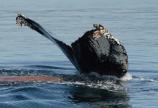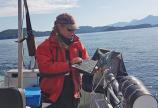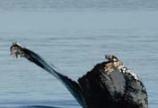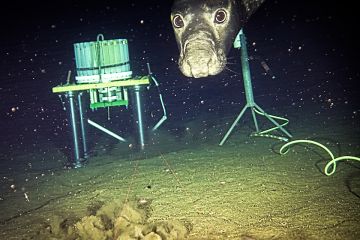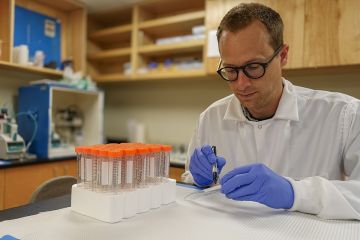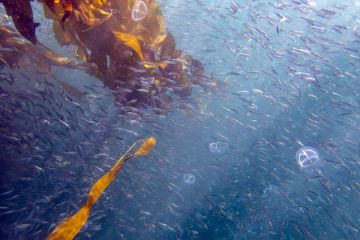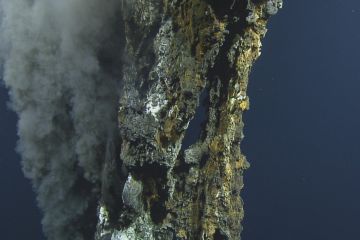What do humpback whales eat in the depths?
- Alf Wilson
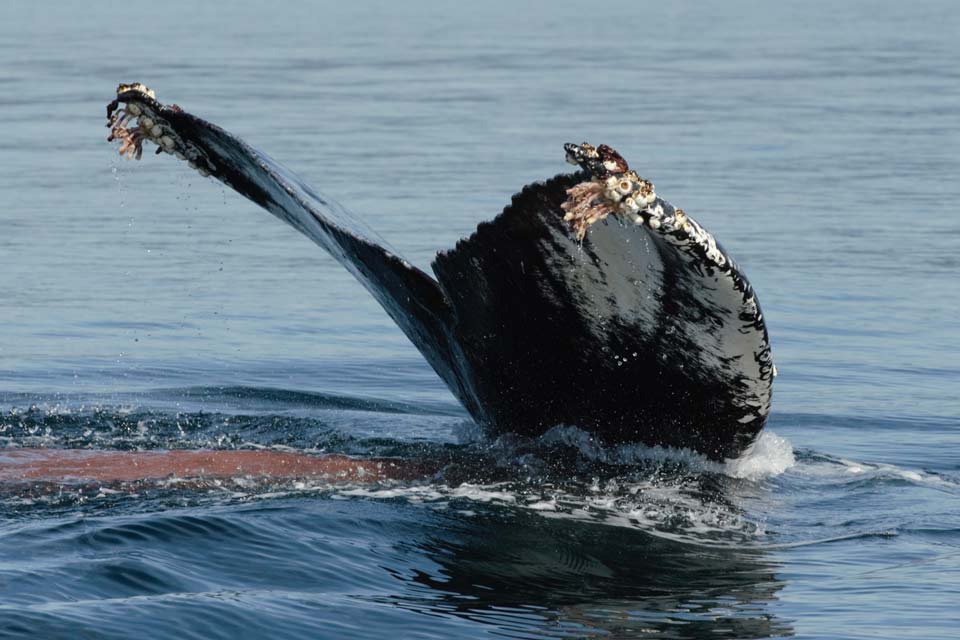
Thanks to DNA analysis and more than a dozen difficult-to-source samples, some answers emerge—from near the tail.
People have been giving Rhonda Reidy a lot of “crap” over the past several years. But don’t worry—she’s been asking for it.
Reidy, fresh from defending her PhD, recently published a paper that pulls together a unique collaboration, a record number of fecal samples, and DNA analysis to tell the surprising story of what some humpback whales in the Salish Sea are eating.
This story really starts in 1999 when Reidy, crewing on a BC whale watching boat, saw her first humpback whale.
After decades, humpbacks were returning to BC waters.
A question formed that stuck with Reidy over the years: how might increasing humpback whale predation impact commercial BC fish populations?
Reidy approached UVic professors Laura Cowen (statistics) and Francis Juanes (biology) about doing a graduate degree to statistically model humpback whale predation. But there was one big problem: no one knows precisely what humpbacks in BC eat at depths of 50–200m underwater, where they primarily feed.
“All of the current data in BC is for humpback whales feeding at the surface. I dug through the literature,” Reidy recalled, “and I just couldn’t find information on what humpback whales are eating underwater, where they spend most of their time.”
Where humpbacks hunt
Reidy used leading tools to study humpback whale deep-water foraging behaviour: acoustic prey mapping (a sophisticated fish finder) and suction-cup tags that collect 3D whale movement.
“We now know where they like to feed, are most often found, and we have pretty good information about their diving behaviour and what the prey in the water column look like, in terms of density and abundance,” says Reidy. “But other than broad categories of fish and zooplankton, we still don’t know precisely what they’re consuming underwater. And that’s why I turned to molecular biology.”
Reidy chose DNA-metabarcoding, a type of PCR test. The Hakai Institute’s Matthew Lemay and Rute Clemente-Carvalho did the first round of DNA analysis—and are already planning to reanalyze Reidy’s samples using techniques that could reveal more details.
“The DNA detections only tell us what is present in the feces,” explains Reidy. “But if there was a high sequence abundance of a specific species, it tells us that’s important prey to pay attention to: either the whale was frequently feeding on that species, or it recently fed on that species.”
As expected, krill was prevalent in 13 of the 14 samples. But Pacific herring, hake and eulachon were also prevalent. Walleye, pollock and sablefish were strongly detected—but only in one sample each, so not prevalent. (It’s not known if this was opportunistic or if the whales were targeting those fish species.)
The interesting result was that the whales may be targeting higher trophic-level fish like pollock and hake, in addition to lower trophic-level fish like herring and anchovy and invertebrates like krill.”
—UVic biology grad researcher Rhonda Reidy
Sample size: cetacean
As it turns out, collecting humpback poop requires good luck, timing and reflexes—it rapidly dissipates, some sinking and some floating away. That’s why humpback feces-collection expeditions have mostly left researchers empty-handed.
“People have tried dedicated humpback whale faecal sampling programs and it just—so far—hasn’t worked very well. You never know when a whale is going to defecate,” Reidy chuckles. “They roam vast areas. You can go days and days without a fecal sample.”
Reidy’s own journey, from whale-watching crew to boat skipper to academic, provided unique connections. And she was savvy enough to recognize her access to—and the respect of—highly qualified personnel.
“I called on my colleagues in the Pacific Whale Watching Association who are out on the water daily—who I trust and know,” Reidy explained. “They know what they’re looking at and they know the animals, and they know to follow the very strict boating rules around the whales.”
Reidy was able to get 18 samples over four seasons for humpback whales in the Salish Sea. Of these, 14 contained faecal matter. No one had ever collected so many Salish Sea humpback faecal samples in such a short time.
So, how is humpback whale poop collected?
“Sometimes you can see the humpback defecate. You bring the boat alongside the feces and I use a pool-skimmer net to scoop as much as I can. Then I scrape it into a new Ziploc bag.” Reidy detailed. “I had a couple of colleagues on a larger boat use a bucket. I had somebody use a water bottle”
Like any leading-edge research, more questions have been raised. But Reidy explains that one thing is now certain: we shouldn’t generalize.
“All of the work that I have done tells me that we cannot assume what the humpback whales are eating underwater,” she says. “Not precisely at the species level.”
But thanks to Reidy’s research, and her less-than-squeamish volunteer collection squad, we’re starting to find out.
Reidy’s research with supervisors Juanes and Cowen reflects UVic’s ongoing commitment to the United Nations Sustainable Development Goal 14, life below water—an area where UVic ranks fifth among all universities worldwide, according to the Times Higher Education Impact Rankings.
Photos
In this story
Keywords: oceans, life below water, research, fisheries, graduate research, wildlife
People: Rhonda Reidy, Francis Juanes, Laura Cowen
Publication: The Ring

